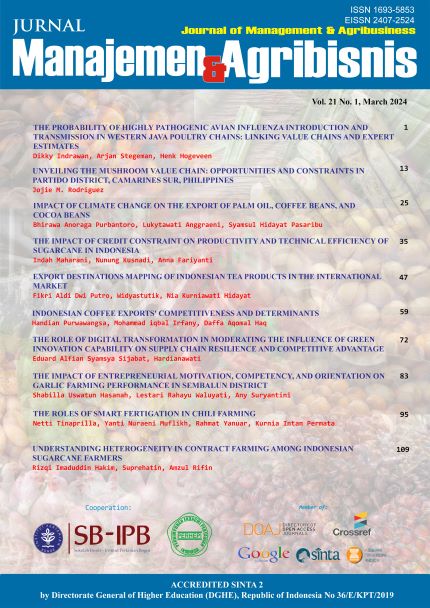The Probability of Highly Pathogenic Avian Influenza Introduction and Transmission in Western Java Poultry Chains: Linking Value Chains and Expert Estimates
Abstract
In Indonesia, several poultry value chains exist in conjunction. The introduction and transmission routes of highly pathogenic avian influenza (HPAI) may differ between these different poultry chains. Consequently, critical areas for control may differ between the poultry value chains and the actors within these chains. However, there is no estimation of the relative importance of the different actors in the Indonesian poultry value chains regarding the probability of HPAI introduction and transmission. To fill this gap, qualitative risk assessments of HPAI introduction and transmission were employed and linked with a previously established value chain map of poultry production in Western Java. Introduction and transmission probability estimates were determined through expert knowledge elicitation. Expert elicitation is acquiring expert opinions on unclear subjects due to insufficient evidence, physical constraints, or resource limitations. Results indicated variable HPAI introduction and transmission risks in the different value chains in West Java, ranging from low to very high. Critical actors were all farming sectors, private collecting farms, traditional outlets, and semi-automated slaughterhouses. Linking the value chain with an expertise-based estimation for introduction and transmission is an efficient and systematic way to identify opportunities for control measures for developing countries.
Keywords: qualitative assessment, HPAI introduction and transmission, value chain map, HPAI, critical control
Authors
Authors who publish with this journal agree to the following terms:
- Authors retain copyright and grant the journal right of first publication with the work simultaneously licensed under a Creative Commons Attribution License that allows others to share the work with an acknowledgement of the work's authorship and initial publication in this journal.
- Authors are able to enter into separate, additional contractual arrangements for the non-exclusive distribution of the journal's published version of the work (e.g., post it to an institutional repository or publish it in a book), with an acknowledgement of its initial publication in this journal.
- Authors are permitted and encouraged to post their work online (e.g., in institutional repositories or on their website) prior to and during the submission process, as it can lead to productive exchanges, as well as earlier and greater citation of published work (See The Effect of Open Access).

